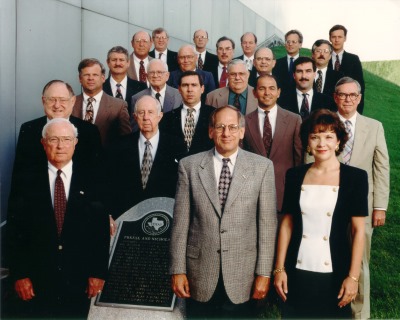The 1990s: The Wake-Up Call We Needed

It only took one year for Freese and Nichols’ euphoria to come crashing down.
1994, the firm’s centennial, had been a year of celebration. The firm had been instrumental in developing Texas’ water resources and continued to be one of the state’s most highly regarded firms. Over the course of 100 years, it had always been profitable.
But Freese and Nichols’ second century in business began with its worst year ever. In 1995, it sustained its first annual loss. The prospect of a sale loomed.
It was just what Freese and Nichols needed.
External Pressures, Internal Problems
The changing Texas landscape of the 1980s and 1990s brought significant external pressures to Freese and Nichols’ business. Dramatic population growth necessitated more and more infrastructure work, which in turn attracted national engineering firms to the state. Freese and Nichols found itself facing greater competition for clients; instead of five firms pursuing a project, there would often be 50. Competition for employees also increased as the national firms sought local connections to the client base.
External pressures also came from other directions. Freese and Nichols’ clients started awarding work differently, many of them adopting policies of spreading work across multiple firms.
Meanwhile, Freese and Nichols’ ways of doing business, although rooted in decades of success, were becoming increasingly unsuitable for the changing industry. The firm had acquired more business and increased its workforce, but its management approach hadn’t adapted.
These systemic issues had been slowly simmering beneath the surface, and they weren’t fully revealed until 1995, as some profitable projects finished up and other projects encountered significant problems.
“We lived for a long time with the benefit of some very large projects that had carried the company, and they masked a lot of other issues,” said Bob Herchert, CEO at the time. “It was a combination of those good projects going away, plus a couple of bad projects on the other side of the equation. … A lot of things came together at the same time.”
“We just didn’t have enough work,” said Mike Nichols, now Chief Operating Officer. “We had built up our staff for a big project, but we didn’t have the systems in place to keep the work coming in once we started winding down.”
A Pivotal Decision: Sell the Company or Make Big Changes
Hovering over all of this was the prospect of a sale. Throughout the professional services industry, larger firms had been buying up midsize firms, and about a year earlier, the Woodward-Clyde Group had approached Freese and Nichols about an acquisition. The two companies decided to take a year to learn more about each other and work together, then revisit the sale offer.
“So, we danced for a year,” said Bob Pence, who went on to become our CEO for 15 years. “and it kind of ground us down to a halt. It’s not that we shut down; it’s that there were no initiatives going on. … We were losing money but ignoring the signs because we were sitting there waiting to decide whether to sell or not.”
Freese and Nichols’ owners faced a pivotal decision as they convened for the annual planning retreat in September 1995. They could sell the company to Woodward-Clyde. Or they could make the radical changes necessary to survive.
“There was some feeling that maybe we couldn’t do all that it would take to turn the ship around,” Herchert said. “… Some of the older owners felt that the younger guys really didn’t want to continue to operate the company and were ready to sell. It’s not what they wanted, but they were willing to go along if that was the prevailing sentiment.”
“The facilitator we hired had us take a straw vote just to see where we stood,” Pence said. “More people said, ‘Don’t sell,’ and it was the younger people. And the minute we had that on the table, the older guys said, ‘You guys don’t want to do this?’ And we said, ‘No, we don’t want to do it.’ ‘Well, hell, we thought you wanted to do it. If you don’t want to do it, we don’t want to do it.’ So we took another vote, and it was unanimous not to sell.”
Added Herchert: “It was an important and significant discussion, and it really bonded the group. … Now that we’d made this decision, we knew we needed to buckle down, get our act together and move forward as a team.”
A Framework for Improvements
Freese and Nichols needed new strategic direction and radical changes to survive. The firm had reputable work and good long-term goals, but it lacked implementation, strategy and measurement.
“We were a very typical consulting firm, very collegial,” Pence says. “Everybody kind of had their own book of business. That’s when we had principals-in-charge — each principal had his or her own group of clients. We worked together, we all loved each other, but we just didn’t have the accountability in the firm. We had some parts that weren’t doing enough work and weren’t making money, and nobody was holding them accountable.”
As the leaders examined how the firm managed its business and searched for a better way, they distilled the challenge to one question: “How do we optimize our response to the market with our limited resources?”
The answer was a new framework called Continuous Improvement, which revolves around planning, measuring and analyzing everything the company does. This approach would transform almost every aspect of Freese and Nichols’ work, culture and client service. A quarter-century later, Continuous Improvement is still how we do our business every day.


